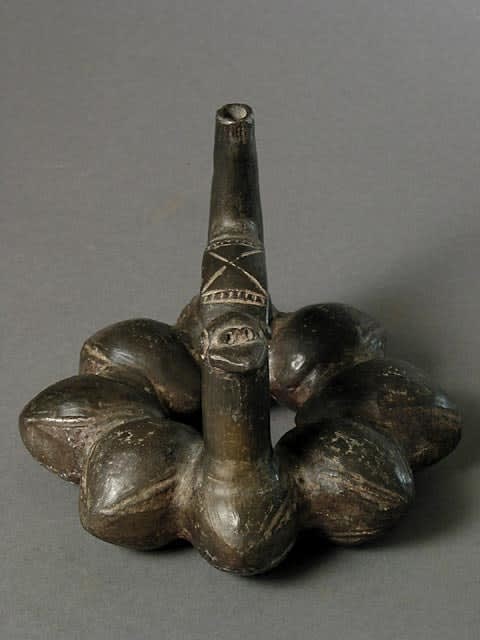Chimu Blackware Stirrup Vessel with a Foul Effigy, 900 CE - 1200 CE
Terracotta
PF.5505
Further images
The Chimu culture arose around 800 A.D. and flourished until the Incan conquest about six hundred years later. Their civilization was centered at their capital Chan Chan, about 300 miles...
The Chimu culture arose around 800 A.D. and flourished until the Incan conquest about six hundred years later. Their civilization was centered at their capital Chan Chan, about 300 miles north of Lima, literally meaning “Sun Sun,” the largest Pre-Columbian city in Peru estimated to contain almost one hundred thousand citizens. The Chimu believed the sea, which they called “Ni,” was the origin of life, a theory also proposed by modern science and evolution. Thanks to their sea-faring skills, the Chimu were able to survive, nestled in between the desert and the sea. The sea was everything to them: an endless supply of food and the source of inspiration for their most imaginative myths, legends, and artwork. Agriculture was also vital, and the Chimu drew up a vast number of irrigation works demonstrating immense engineering skill, some of which are still in use today. Today, aside from the astounding mud ruins of Chan Chan remarkably well preserved in the heat of the desert, the Chimú are perhaps best known for their distinctive black glazed pottery influenced by their predecessors: the Moche.
This mysterious vessel lends itself to a variety of interpretations. The head of a duck or such a water based foul emerges from a ring of eight nut-shaped objects. A spout projects on the other end opposite the bird and a stirrup handle connects the two. The wonder of this object lies in the interpretation of the eight oval forms connected by the sides. Perhaps the most intriguing theory takes into consideration the location of the discovery of the vessel. Found buried inside a tomb, this work might represent a newborn bird emerging from a ring of eggs. This would symbolize the rebirth and regeneration of the deceased believed to take place in the afterlife. However, the objects might represent nuts or seed as well. Perhaps the bird head is that of a deity associated with a type of seed or nut. Often ancient Peruvian artist would depict the face of gods atop foods, the maize god being the most frequent example. This blackware pottery piece is an interpretation of life created almost a thousand years ago. Overall, the magic and mystery of this vessel is suggestive of the greater wonder of ancient civilizations and the achievements and beliefs of those who came before us.
This mysterious vessel lends itself to a variety of interpretations. The head of a duck or such a water based foul emerges from a ring of eight nut-shaped objects. A spout projects on the other end opposite the bird and a stirrup handle connects the two. The wonder of this object lies in the interpretation of the eight oval forms connected by the sides. Perhaps the most intriguing theory takes into consideration the location of the discovery of the vessel. Found buried inside a tomb, this work might represent a newborn bird emerging from a ring of eggs. This would symbolize the rebirth and regeneration of the deceased believed to take place in the afterlife. However, the objects might represent nuts or seed as well. Perhaps the bird head is that of a deity associated with a type of seed or nut. Often ancient Peruvian artist would depict the face of gods atop foods, the maize god being the most frequent example. This blackware pottery piece is an interpretation of life created almost a thousand years ago. Overall, the magic and mystery of this vessel is suggestive of the greater wonder of ancient civilizations and the achievements and beliefs of those who came before us.







